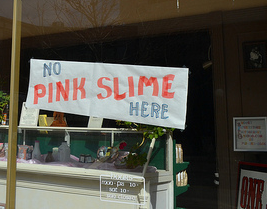Beaver Anal Gland Sacs & Other Weird Stuff You've Probably Eaten
All the talk about “pink slime” had us wondering, “What other weird things have we been eating?!” While the answers provided by the foodies at Consumer Reports often didn’t come with illustrative names such as pink slime, it did leave us a better bit informed — and a lot less hungry!
Aside from “ammoniated beef” (the food industry’s term for pink slime, or ammonia gas-treated ground meat) here’s what else we all probably scarfed down:
- Castoreum — An extract made from dried, ground-up “sacs located by the anal glands of beavers.” It can be added to foods (“especially as vanilla flavoring,” says Wikipedia) such as gums, alcohol, candy and baked goods.
- Bacteriophages — If you remember your bio-chem days, this is the technical name for viruses that kill other viruses. It’s sprayed onto “ready-to-eat” meat products to kill the bug that responsible for listeriosis infections.
- Transglutaminase — It’s the enzyme that “glues” pieces of meat together. And while it won’t be listed on a product’s label, if you’ve ever eaten something made with “reformed and shaped chicken breast” or “formed turkey thighs,” then you’ve scarfed down some of this goo, too.
- Rennet — A food additive that comes from the milk-fed calves stomachs used to thicken custards.
- Shellac — These secretions from the Asian lac bug are used to coat candies, pills and apples to give them a nice, smooth, shiny finish–just like the varnishes used on woodwork.
If you want the complete story on other additives we’ve probably stuffed down our pie holes unknowingly, check out Consumer Reports ShopSmart’s story (PDF): What’s really in our food.
Excuse us while we go start our own farm.
Want more consumer news? Visit our parent organization, Consumer Reports, for the latest on scams, recalls, and other consumer issues.


